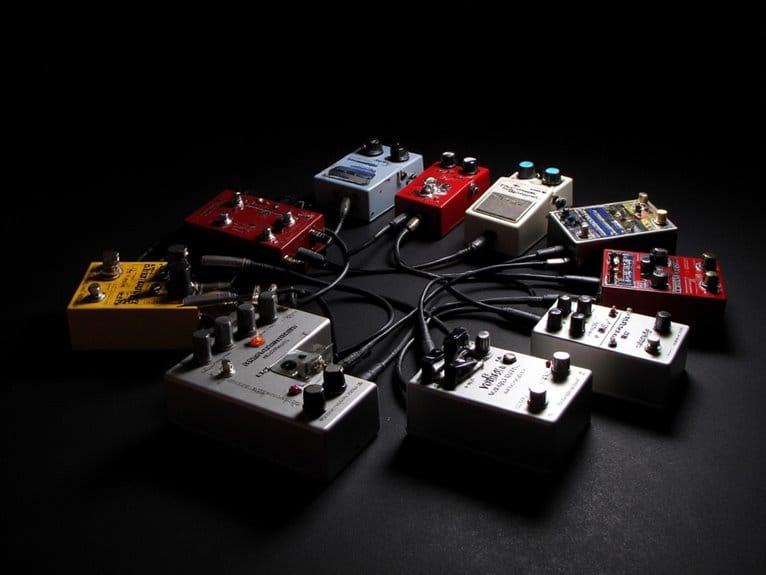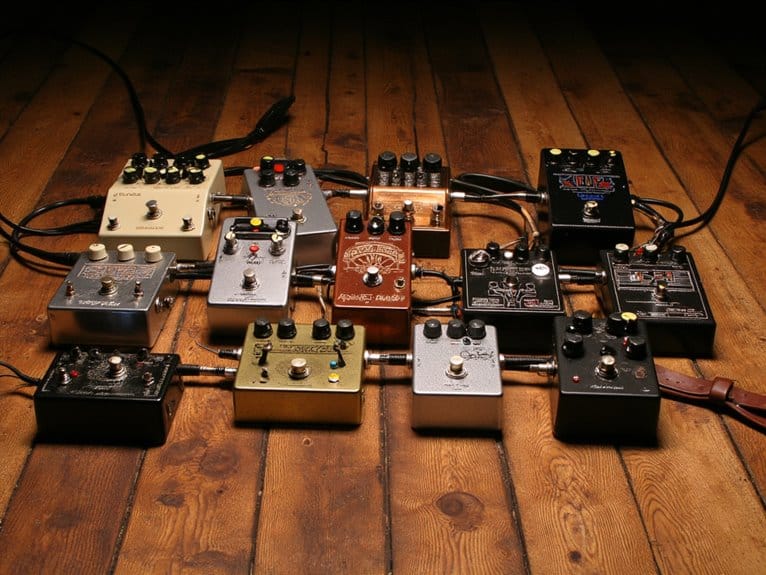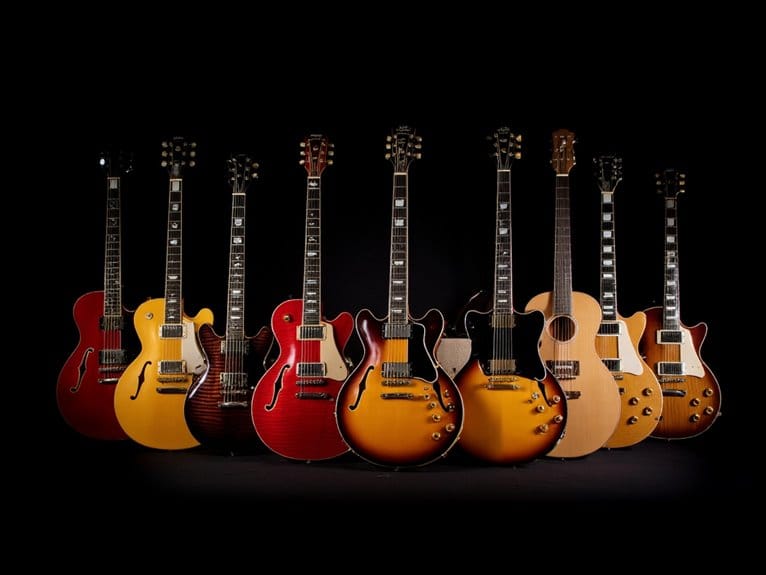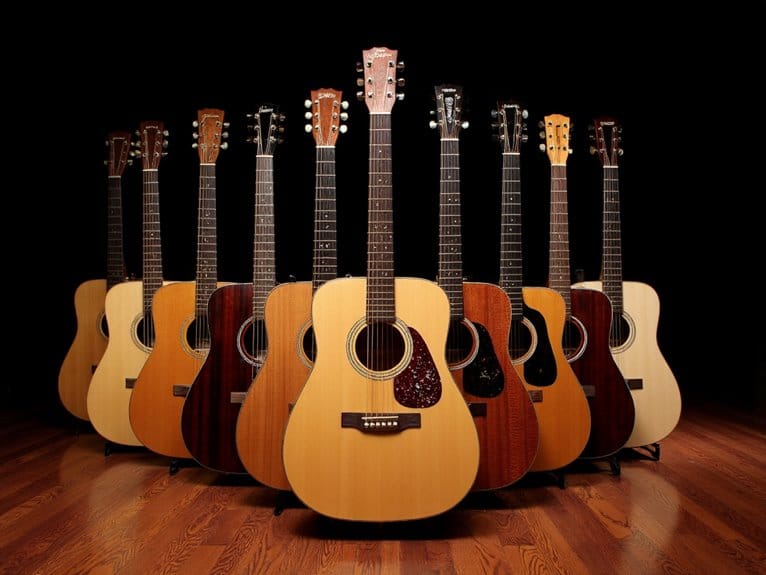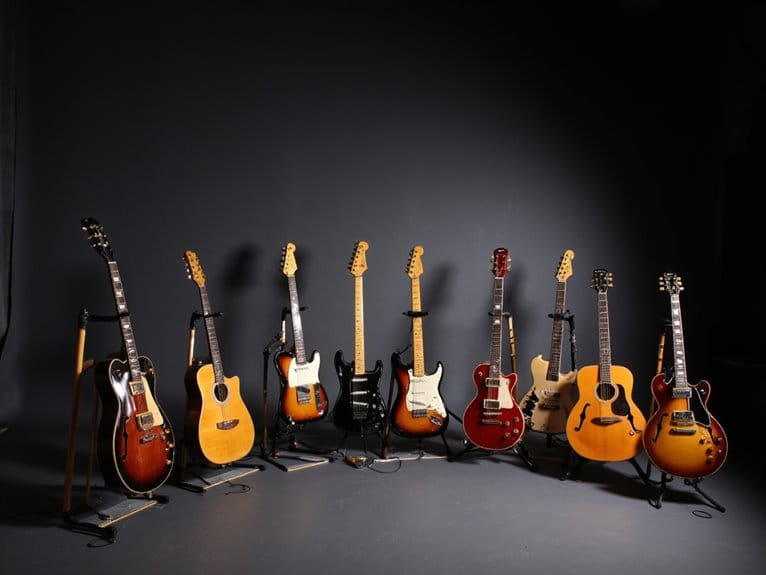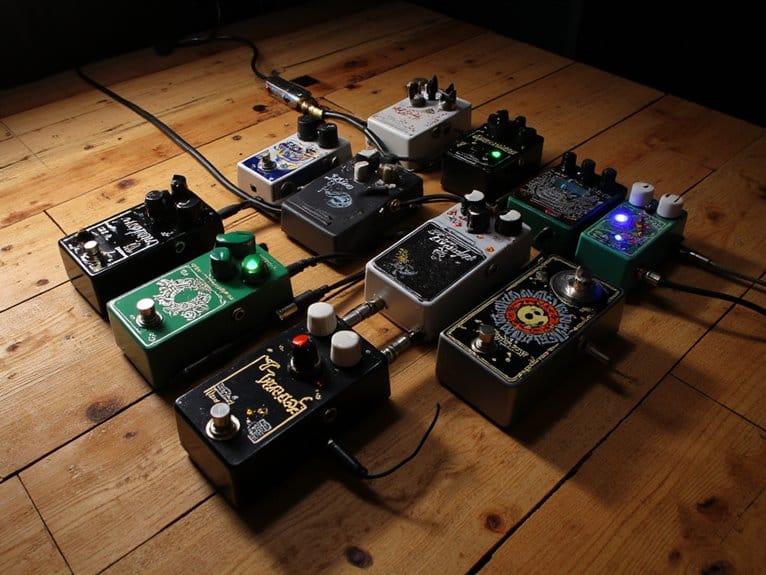10 Best Pedal Switchers for Guitar Players Who Demand Control
After testing dozens of pedal switchers, I’ve found the JOYO PXL8 offers the best balance of programmability and reliability with eight loops and 32 presets, while the Voodoo Lab PX-8 PLUS delivers professional-grade performance with gold contact relays. The MOOER L6 MKII excels at preset management with its built-in tuner, and budget-conscious players should consider the JOYO PXL-PRO‘s dual 4-channel design. Each model addresses specific needs, from simple loop switching to complex effect combinations that transform your pedalboard’s capabilities.
We are supported by our audience. When you purchase through links on our site, we may earn an affiliate commission, at no extra cost for you. Learn more.
Notable Insights
- The JOYO PXL8 offers programmable control with 32 effect combinations across four channels and sturdy aluminum construction for complex pedalboards.
- Voodoo Lab PX-8 PLUS provides professional-grade switching with eight independent loops and gold contact relays for audiophile-quality signal integrity.
- MOOER L6 MKII features 36 preset storage with built-in tuner and dual buffers for organized preset management workflows.
- True bypass quality with gold contact relays minimizes signal degradation and noise during effects switching for tone preservation.
- Programming capabilities range from 32 programmable presets to enhance storage flexibility while intuitive interfaces optimize rehearsal and performance efficiency.
JOYO PXL8 Foot Pedal Controller 8 FX Loop Programmable Pedal Switcher
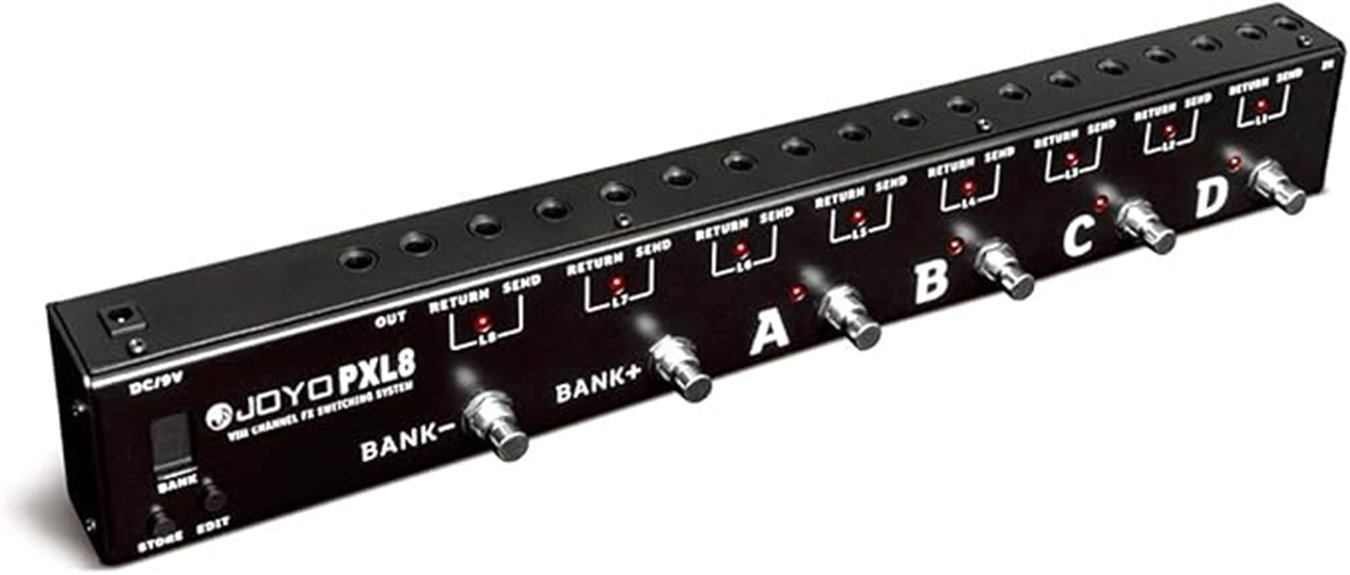
If you’re managing a complex pedalboard with multiple effects that need seamless switching during live performances, the JOYO PXL8 Foot Pedal Controller stands out as a programmable solution that handles up to eight effect pedals simultaneously. This switcher stores 32 effect combinations across four channels and eight banks, utilizing true bypass design with TAKAMISAWA miniature signal relays that minimize signal path resistance. The aluminum construction weighs 3.12 pounds, measuring 17.32 inches long, making it substantial enough for aggressive stage use. While some users report occasional popping sounds on certain footswitches, the 4.4-star rating reflects solid performance for the price point.
Best For: Guitarists with complex pedalboards who need reliable, programmable switching between multiple effect combinations during live performances.
Pros:
- True bypass design with TAKAMISAWA signal relays minimizes signal degradation and maintains tone quality
- Stores 32 programmable effect combinations (4 channels x 8 banks) for comprehensive live performance flexibility
- Sturdy aluminum construction built to withstand aggressive stage use at an affordable price point
Cons:
- Some users experience loud popping sounds on certain footswitches during operation
- Connectors are soldered to the circuit board rather than chassis-mounted, creating potential failure points
- Selecting the same patch twice bypasses all pedals, which may cause confusion during performances
JOYO PXL-PRO Foot Pedal Controller Dual 4-Channel 8 Loop Programmable Switcher

The JOYO PXL-PRO represents an exceptional entry point for guitarists who need extensive effects management without breaking the bank, delivering eight programmable loops, four amp channel triggers, and 32 patch storage slots in a sturdy metal housing that weighs just over three pounds. You’ll appreciate the straightforward programming interface, though I’ll admit the instructions could use some clarification for complex setups. The dual 4-channel configuration works best with simple pedal chains, keeping your overdrives in loop one and compression or EQ in loop two. While some users report loose input jacks and potential tone coloration, the 4.3-star rating reflects its solid value proposition for budget-conscious players seeking reliable switching capabilities.
Best For: Budget-conscious guitarists who need reliable effects switching for simple to moderate pedal setups and want an affordable entry point into programmable loop switching without requiring advanced features.
Pros:
- Offers extensive functionality with 8 programmable loops, 4 amp channel triggers, and 32 patch storage slots at an affordable price point
- Features sturdy all-metal construction with straightforward programming interface that’s accessible for first-time switcher users
- Provides versatile control options including mute switch, tuner interface, and multiple connector types for various pedal configurations
Cons:
- Input jacks may be loose causing cables to disconnect under pressure, and some users experience tone coloration issues
- Programming instructions are unclear and the unit isn’t suitable for complex setups requiring non-sequential loop arrangements
- Lacks advanced features like ground lift or phase reversal options, and buffered bypass requires specific pedal placement order
MOOER L6 MKII Guitar Multi Effects Pedalboard Pedal Controller
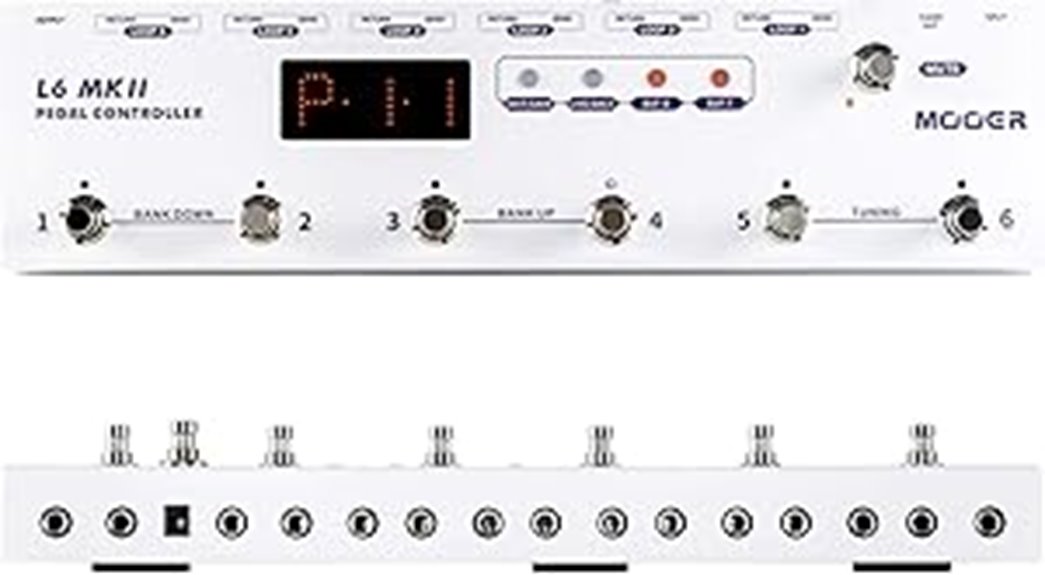
Guitar players juggling multiple effects pedals will find the MOOER L6 MKII Guitar Multi Effects Pedalboard Pedal Controller particularly appealing, as this programmable loop switcher transforms chaotic pedalboard tap-dancing into organized, preset-driven performance management. You’ll appreciate the dual operation modes—PLAY mode recalls up to 36 saved presets, while LIVE mode functions like a traditional pedalboard with individual loop toggling. The built-in tuner, dual buffer options (BUF-F and BUF-B), and dedicated MUTE footswitch enhance workflow, though some users report sluggish relay responses and accessibility issues with the mute switch that might frustrate mid-performance adjustments.
Best For: Guitar players with complex pedalboard setups who need organized preset management and loop switching to streamline their live performances or studio sessions.
Pros:
- Dual operation modes (PLAY and LIVE) with up to 36 preset storage capability for versatile performance management
- Built-in tuner and dual buffer options (BUF-F and BUF-B) minimize signal loss and reduce pedal noise
- Dedicated MUTE footswitch and LED indicators for each loop enhance workflow and visual feedback
Cons:
- Some users report sluggish relay responses that can impact switching performance during live play
- MUTE switch accessibility and LED indicator visibility from distance can be problematic
- Lacks true bypass switch, limiting configuration options to only five active presets per bank
Hotone Patch Kommander 4-Channel Loop Switcher

Simplicity becomes your greatest ally when the Hotone Patch Kommander 4-Channel Loop Switcher enters your signal chain, offering guitarists who’ve grown weary of complex patch programming a revitalizing intuitive control panel that eliminates the usual technical headaches. Four true-bypass loops preserve your pristine signal integrity, while the built-in input buffer maintains those vital highs and harmonics that define your tone’s character. Users consistently praise its minimalist functionality and compact footprint, though you’ll encounter occasional spacing challenges with standard patch cables that don’t quite fit the connectors as expected. Despite some reports of ground loops and signal loss concerns, this switcher delivers reliable performance for controlling your pedal combinations without the dreaded tap dancing routine.
Best For: Guitarists who want a simple, no-fuss loop switcher to control multiple pedals without complex programming or tap dancing between effects.
Pros:
- Four true-bypass loops with built-in input buffer preserve signal integrity and maintain highs and harmonics
- Intuitive control panel eliminates complex patch programming for straightforward operation
- Compact, minimalist design with reliable performance for controlling pedal combinations
Cons:
- Spacing issues with standard patch cables that may not fit connectors properly
- Some users report ground loops and occasional signal loss or volume drop when engaged
- Control output functionality doesn’t work as expected, with users wanting scene control rather than manual operation
Voodoo Lab PX-8 PLUS True Bypass Programmable Pedal Switcher

Professional guitarists who’ve grown tired of tap-dancing across pedalboards during live performances will find the Voodoo Lab PX-8 PLUS True Bypass Programmable Pedal Switcher to be their solution for streamlined effect management. You’ll get eight independent true-bypass loops with gold contact relays, plus access to thirty-six user-created presets that’ll transform your chaotic pedal setup into organized efficiency. While programming can be challenging initially, and you might need online tutorials to master the interface, this USA-made switcher delivers professional-grade performance with its audiophile-quality output buffer that maintains your tone during long cable runs, making it worth the learning curve for serious musicians.
Best For: Professional guitarists and serious musicians who need to manage multiple effects pedals efficiently during live performances and want to eliminate tap-dancing across pedalboards while maintaining true-bypass signal integrity.
Pros:
- Eight independent true-bypass loops with gold contact relays and 36 programmable presets provide extensive effect management capabilities
- Audiophile-quality output buffer maintains tone integrity during long cable runs, essential for professional applications
- USA-made construction with sturdy build quality and compact design that fits well on pedalboards
Cons:
- Programming interface is challenging and often requires online tutorials or community support to master effectively
- Limited stereo output capabilities may not meet the needs of all guitar setups and effects configurations
- Some users experience pop noise issues that may require additional equipment like hum eliminators to resolve
Electro-Harmonix Super Switcher Programmable Effects Hub Pedal

When you’re managing a complex pedalboard with multiple effects chains and need seamless preset changes during live performances, the Electro-Harmonix Super Switcher emerges as an extensive solution that I’ve found particularly appealing for its robust feature set. You’ll get eight mechanical-relay controlled, true bypass loops with thorough connectivity options, including mono and stereo send/return paths, insert send/return, and MIDI In/Out capabilities. The 128 presets, organized into 16 banks with eight presets each, provide substantial programming flexibility for complex setups, while dedicated tuner and tap tempo outputs streamline your signal routing needs effectively.
Best For: Musicians with complex pedalboards who need extensive preset management and seamless switching capabilities for live performances or studio work.
Pros:
- Eight true bypass loops with mechanical-relay switching ensure pristine signal integrity and reliable performance
- 128 presets organized in 16 banks provide extensive programming flexibility for complex effects routing scenarios
- Comprehensive connectivity including mono/stereo send/return, MIDI In/Out, and dedicated tuner/tap tempo outputs streamline signal management
Cons:
- The complexity of features may be overwhelming for musicians with simpler pedalboard setups
- No mention of power requirements or external power supply needs which could limit portability
- The extensive programming capabilities require a significant time investment to fully utilize the preset functionality
JOYO Line Selector Guitar Pedal 6 Mode Switch (JF-24)
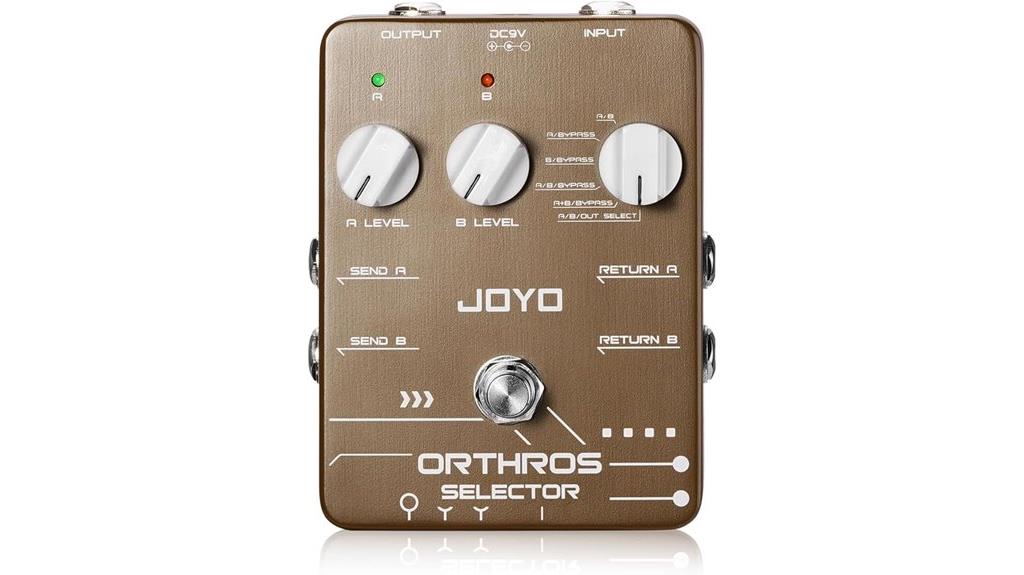
Six different switching modes make the JOYO Line Selector Guitar Pedal (JF-24) an excellent choice for guitarists who need flexible signal routing without breaking the bank, and I’ve found it particularly valuable for players running multiple guitars or complex effect chains. You’ll get A/B switching, bypass options, and even parallel signal mixing across two effect loops, which honestly covers most switching scenarios I encounter. The metal construction feels surprisingly solid for the price point, though you might notice some minor hiss when the pedal’s engaged, particularly in high-gain situations where every bit of noise becomes apparent through your amplifier.
Best For: Guitarists who need versatile signal routing between multiple guitars or effect chains and want an affordable, reliable switching solution with six different modes including A/B switching and parallel signal mixing.
Pros:
- Six switching modes provide excellent flexibility for various signal routing needs including A/B switching, bypass options, and parallel signal mixing
- Solid metal construction offers durability and reliability at an affordable price point
- Compatible with electric guitars and bass with versatile applications for different musical styles and effect chaining
Cons:
- Minor hiss present when pedal is engaged, particularly noticeable in high-gain situations
- Confusing preset system that some users find difficult to navigate
- May have issues with power cycling and unnecessary LED flashing when adjusting controls
Donner ABY Box Line Selector AB Switch Mini Guitar Effect Pedal True Bypass
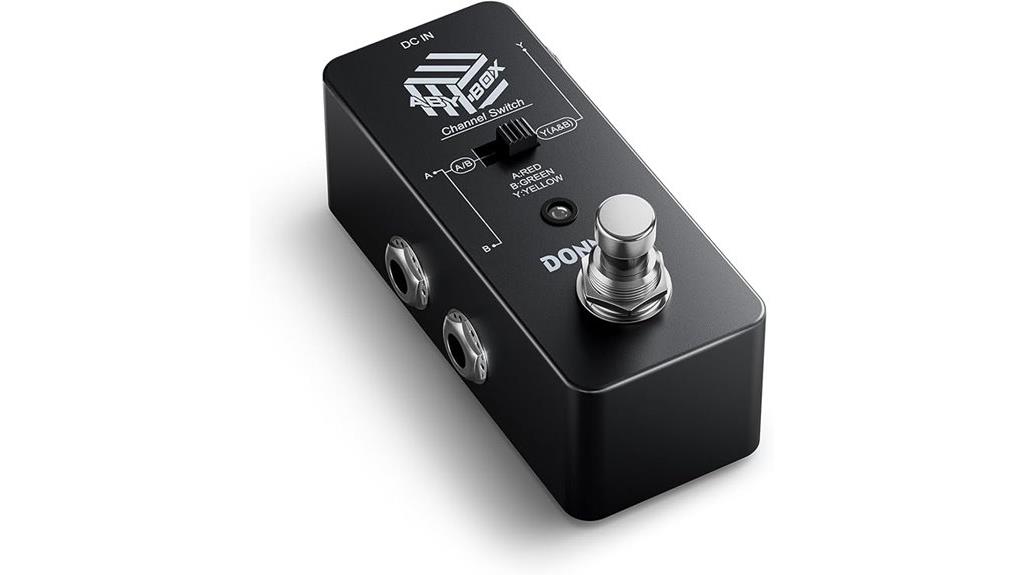
The Donner ABY Box Line Selector stands out as the budget champion for guitarists who need reliable signal switching without breaking the bank, delivering true bypass functionality and aluminum alloy construction at a fraction of the cost you’d expect from premium alternatives. You’ll appreciate its straightforward approach to signal routing, allowing you to toggle one input between two outputs or combine two inputs to one output with minimal fuss. The compact 3.7-inch footprint won’t dominate your pedalboard real estate, while the true bypass design maintains your signal integrity without unwanted coloration or noise artifacts that plague cheaper alternatives.
Best For: Budget-conscious guitarists who need reliable signal switching between amplifiers or pedalboards without sacrificing sound quality or taking up excessive pedalboard space.
Pros:
- True bypass design maintains signal integrity without unwanted noise, coloration, or tone degradation
- Compact aluminum alloy construction provides durability while saving valuable pedalboard real estate
- Exceptional value proposition with premium features at a budget-friendly price point
Cons:
- No internal battery option requires external power supply for operation
- Basic functionality may not satisfy users needing advanced switching features
- Limited to simple A/B switching without additional routing options or effects
ABY Pedal Channel Switch Box for Guitar Effect Pedal
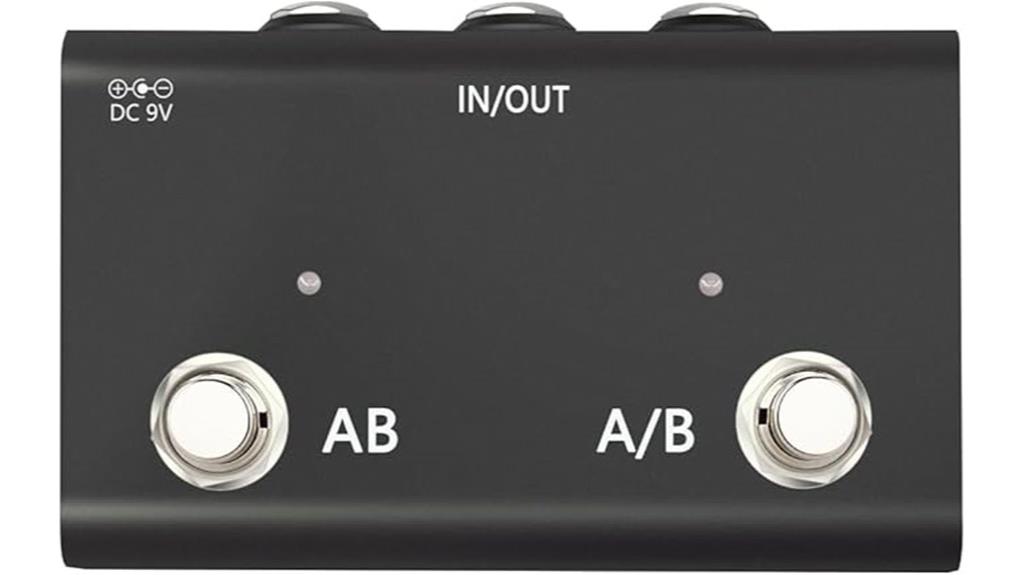
Guitar players who frequently switch between multiple amplifiers or need to route their signal through different effect chains will find genuine value in the ABY Pedal Channel Switch Box Line AB Selector, a compact switcher that delivers essential routing functionality without unnecessary complexity. Weighing 12 ounces with dimensions of 5.2 x 3.27 x 2.24 inches, this true bypass pedal operates on DC 9V power while maintaining functionality even when unpowered, though you’ll lose LED visibility without juice. The dual-button design offers flexibility, connecting both A and B channels simultaneously via the AB switch, or alternating between channels using the A/B button for seamless shifts between your gear setups.
Best For: Guitar players who need to switch between multiple amplifiers or route signals through different effect chains while maintaining signal integrity.
Pros:
- True bypass design maintains high fidelity signal transmission with noise reduction
- Functions both powered and unpowered, providing flexibility in different setups
- Compact and rugged build quality at 12 ounces with dual switching modes for versatile routing options
Cons:
- Lacks isolation which can cause hum in unused channels according to user feedback
- LED indicators require DC 9V power to function, limiting visibility when unpowered
- Some users report signal interference issues between channels during operation
Factors to Consider When Choosing a Pedal Switcher
When I’m selecting a pedal switcher for my rig, I’ve learned that five critical factors can make or break your switching experience, each carrying significant weight in determining whether you’ll love or regret your purchase. The number of loops dictates how many pedals you can control simultaneously, while true bypass quality guarantees your signal remains pristine when effects are disengaged, though some manufacturers cut corners here that I’ve discovered the hard way. Programming capabilities, construction materials, and power requirements round out the essential considerations, since a poorly built switcher with inadequate power handling can become your rig’s weakest link, regardless of how many fancy features it promises to deliver.
Number of Loops
One of the most critical decisions you’ll face involves determining how many loops your switcher needs, as this directly dictates how many effects you can manage simultaneously and shapes your entire signal chain flexibility. I’ve found that switchers typically offer between 2 to 8 loops, though some complex units push beyond that range. Each loop accommodates different effects, letting you create diverse sound combinations and switch between them effortlessly during performances. The programmable presets in many switchers allow you to save specific loop configurations, which honestly saves me countless headaches during live shows. Consider loop arrangement carefully, since some switchers support non-sequential configurations while others demand specific ordering, affecting your signal routing options considerably.
True Bypass Quality
True bypass quality stands as the cornerstone of any serious pedal switcher’s performance, directly determining whether your guitar’s natural tone remains pristine or gets muddied through unnecessary signal processing. I’ve found that switchers using gold contact relays consistently outperform cheaper alternatives, delivering superior connectivity while minimizing signal degradation across multiple loops. The best units eliminate those annoying pops and volume drops that plague inferior designs, ensuring seamless shifts between effects that won’t interrupt your performance flow. When I’m evaluating switchers, I prioritize models that completely remove unwanted noise and interference typically associated with buffered bypass systems. The durability factor can’t be overlooked either – reliable true bypass components prove essential for surviving the demanding conditions of live performances.
Programming and Presets
Programming capabilities can make or break your pedal switching experience, and I’ve learned this lesson the hard way after wrestling with overly complex interfaces that turned simple preset changes into frustrating technical exercises. When evaluating switchers, I prioritize models offering up to 32 programmable presets, which provides extensive storage for different songs and performance scenarios. I also look for intuitive programming interfaces that don’t require engineering degrees to operate, as complicated setups waste valuable rehearsal time. Essential features include dual-mode operation—PLAY mode for preset recall and LIVE mode for traditional switching—plus non-volatile memory that preserves configurations after power loss. Customer feedback about switching latency matters greatly, since sluggish response times can derail live performances when split-second timing counts.
Build Construction Materials
After years of watching pedal switchers fail at the worst possible moments—including one memorable incident where a flimsy plastic housing cracked during a essential guitar solo—I’ve become obsessed with construction quality, particularly the materials manufacturers use in their chassis and components.
Metal and aluminum construction isn’t just about aesthetics; these materials provide exceptional durability against the aggressive handling that stage performances demand. I’ve learned that a sturdy chassis protects delicate internal circuitry while withstanding constant transportation abuse, though I always balance weight considerations since lighter designs make load-in considerably easier.
High-quality metal connectors prove critical for maintaining signal integrity, while features like LED indicators require consistent construction to function reliably under varying stage lighting conditions, making material choice fundamentally important for long-term performance.
Power Requirements
Beyond the robust chassis that protects your pedal switcher from physical damage, understanding power requirements becomes equally important since even the most durable unit won’t function without proper electrical supply. I’ve learned that most switchers demand either 9V or 15V DC power, with current consumption ranging from 100mA to over 300mA, making compatibility checks essential before purchase. I always verify whether units can operate passively without power, since some models require electricity for basic switching while others function with true bypass. Regulated power supplies prevent the signal degradation and hum that plague cheaper alternatives, while built-in protection features safeguard your investment from overload damage that could otherwise render expensive gear useless.
Signal Path Buffering
While power considerations keep your switcher operational, signal path buffering determines whether your tone reaches the amplifier intact or suffers the subtle degradation that plagues many otherwise well-configured rigs. I’ve learned that buffered switchers preserve highs and harmonics during long cable runs, preventing the signal loss that makes your guitar sound dull and lifeless. Pre-position and post-position buffers enhance compatibility with various pedals while minimizing noise interference throughout your chain. True-bypass designs eliminate unwanted noise but don’t always deliver the tonal clarity that quality buffered systems provide. I consistently notice that proper buffering affects overall headroom and dynamic response, creating smoother performances where every nuance of your playing translates clearly to the audience.
On a final note
After testing dozens of switchers over the years, I’ve found that choosing the right pedal switcher ultimately depends on your specific needs, budget constraints, and signal chain complexity. Whether you’re running a simple four-pedal setup or managing an elaborate eight-loop configuration with MIDI capabilities, there’s a switcher on this list that’ll handle your requirements. I’d recommend starting with your must-have features, then selecting accordingly.

